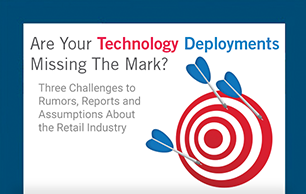 In many ways, we take voice communications for granted. It’s easy to forget how powerful simple voice communications can be and how much more quickly the human brain can process voice over text. In office environments, associates typically have access to face-to-face communications in real time, and also a plethora of tools like phones, video conferencing and physical proximity. However, this is not the case in retail environments, where associates are scattered out on the floor, at the POS, in the back office or in the fulfillment center. Yet their need for information in real time is critical as they interact with customers, handle unexpected situations and work to deliver the right merchandise to the right person and place.
In many ways, we take voice communications for granted. It’s easy to forget how powerful simple voice communications can be and how much more quickly the human brain can process voice over text. In office environments, associates typically have access to face-to-face communications in real time, and also a plethora of tools like phones, video conferencing and physical proximity. However, this is not the case in retail environments, where associates are scattered out on the floor, at the POS, in the back office or in the fulfillment center. Yet their need for information in real time is critical as they interact with customers, handle unexpected situations and work to deliver the right merchandise to the right person and place.
VoCoVo saw the opportunity to help retail associates collaborate more effectively and do their jobs better using voice technology. Our headsets allow associates to tap into all the people on that specific ‘conference,’ receiving and sending timely voice communications.
Use cases for voice communications in retail
This may not seem like a transformational kind of deployment. After all, retail associates have phones and ipads and cross paths regularly. Is it really possible for voice communications to transform operations, the customer experience and other aspects of retail? Well, based on our installation base, we have some pretty compelling results to show. Here are some use cases of actual VoCoVo customers and the impact that voice is having in different areas of their businesses.
Customer service – With the push of a button, customers can connect with an associate when standing in front of locked merchandise. Customers in the fitting rooms can also use a voice request to ask an associate to bring them apparel in a different size. When integrated with facial recognition technology, associates can be notified of the name of the customer who has just entered the store so that they can be greeted personally.
Simplified order collection – When a customer arrives, with the press of a button, they can connect with an associate in the fulfillment center. That associate can search for the customer’s order and carry it out to them immediately without the extra step of an associate going out to talk to the customer, walking back to the fulfillment center, and carrying the order back out. This level of efficiency drives productivity and speed over hundreds of orders and dozens of employees.
Streamlined operations – In one store, our headsets have been integrated with the camera/people counting system so that the number of customers entering the store is calculated. Using AI, the system notifies associates that they need to open three more registers in the next 15 minutes to accommodate customer checkouts. Likewise, the system notifies them when they may close down registers. The system orchestrates operations to optimally accommodate customers during peak traffic hours for greater efficiency.
Safety – Headsets allow associates to feel connected with one another, which delivers a feeling of safety. Our headsets have a panic feature that allows an associate to press a button to connect with a corporate monitoring system or even local law enforcement in case of an incident.
Sustainability – Headsets are used by one customer to send messages to stores each night to close freezer blinds, a simple activity that reduces energy use. The simple voice request allows associates to respond when the task is completed. Thanks to the constant, consistent closing of these blinds, the company has reaped energy savings in the millions.
These use cases are only the beginning. The potential for voice to integrate with even more technologies, to incorporate AI for smarter decision-making and further empower associates is virtually limitless. Beth Bergmann and I discuss the present and future of voice communication technology in retail on the Telaid Tech Connect podcast. I invite you to listen to consider the possibilities and reach out to us at VoCoVo.




